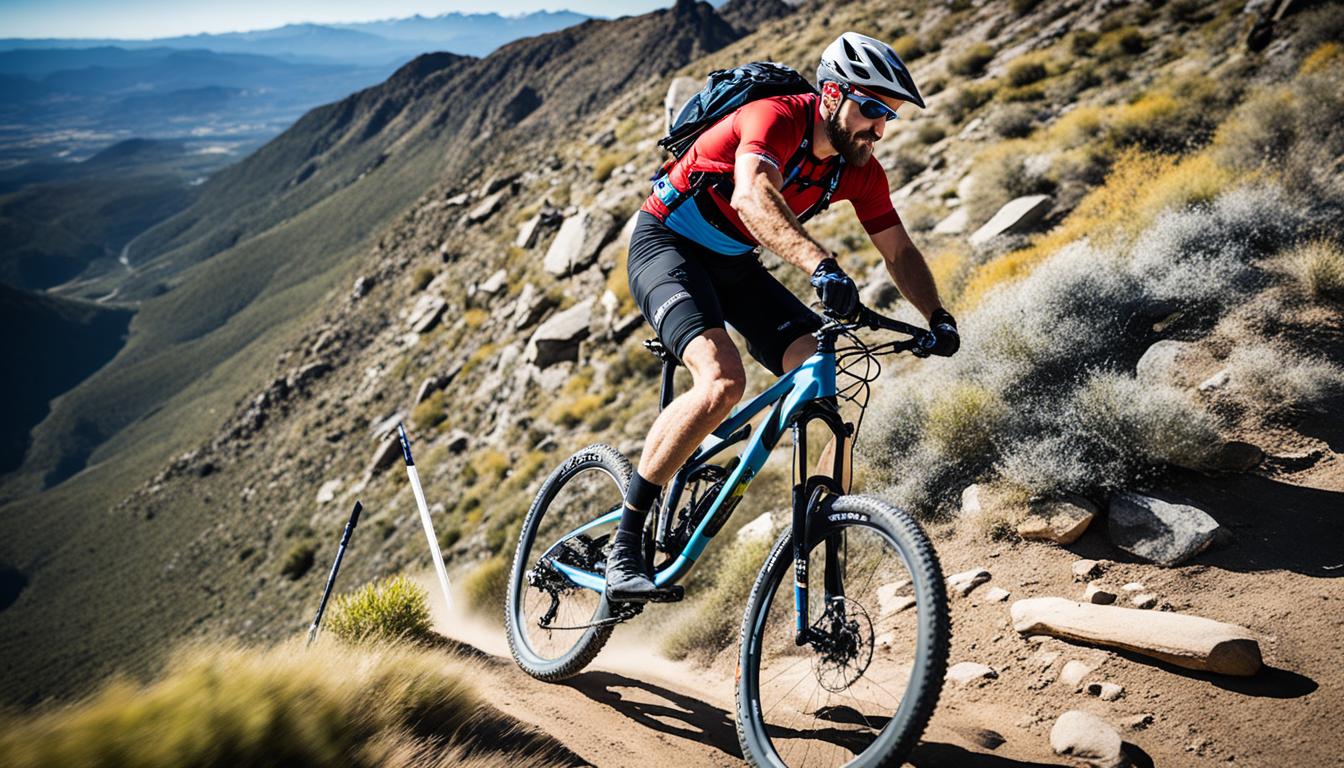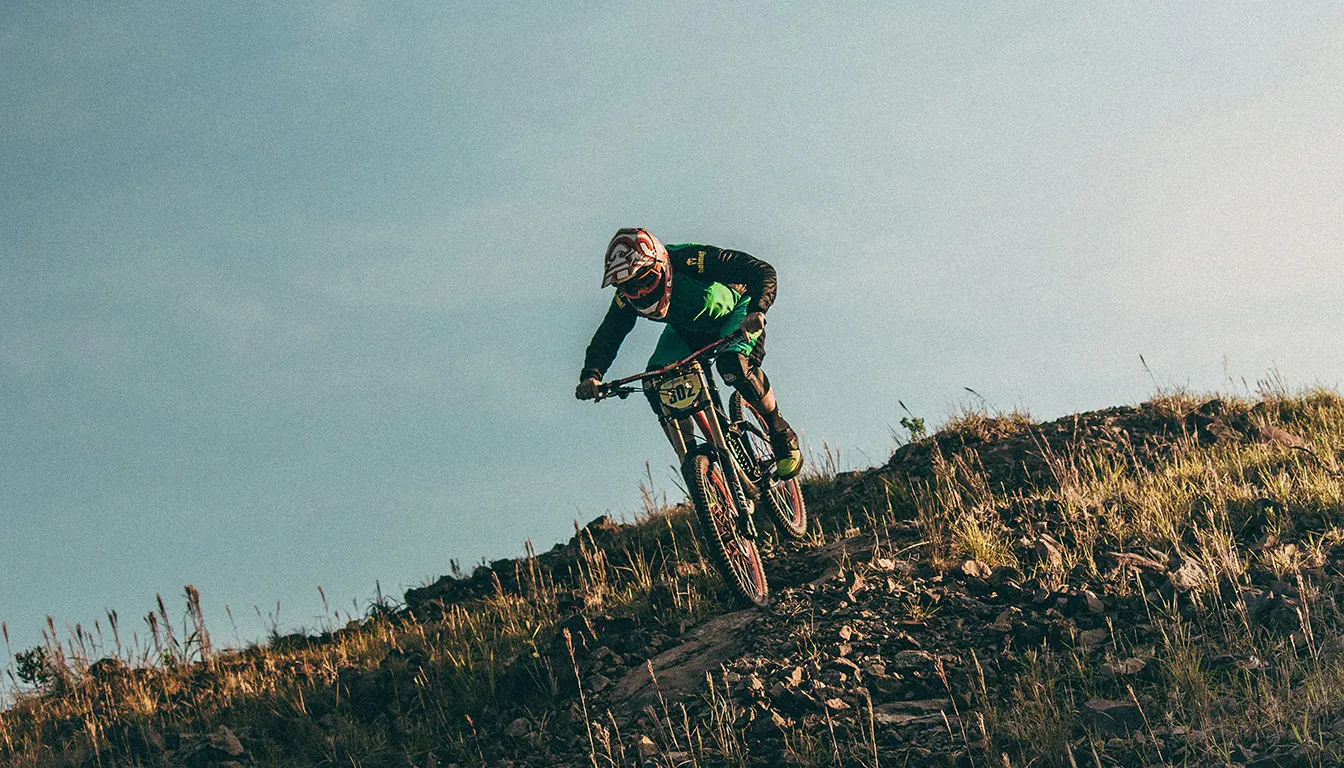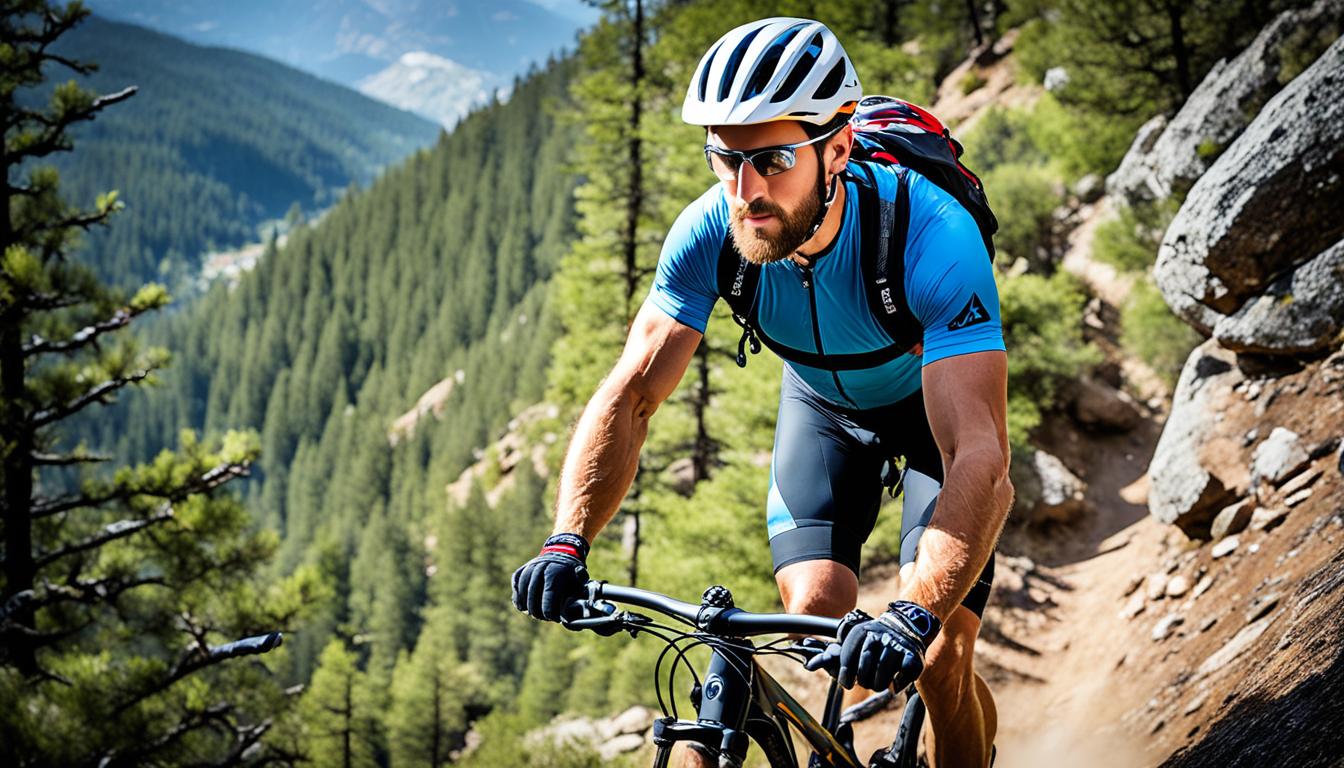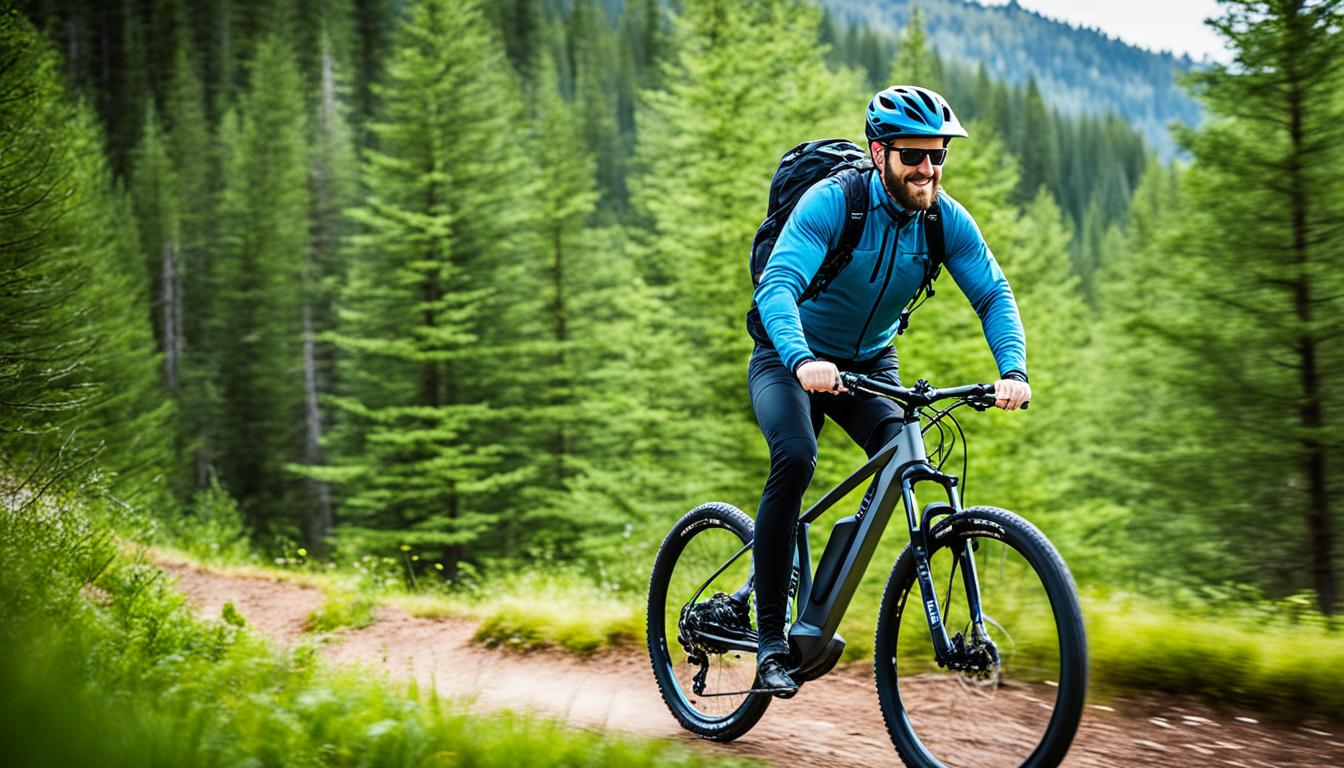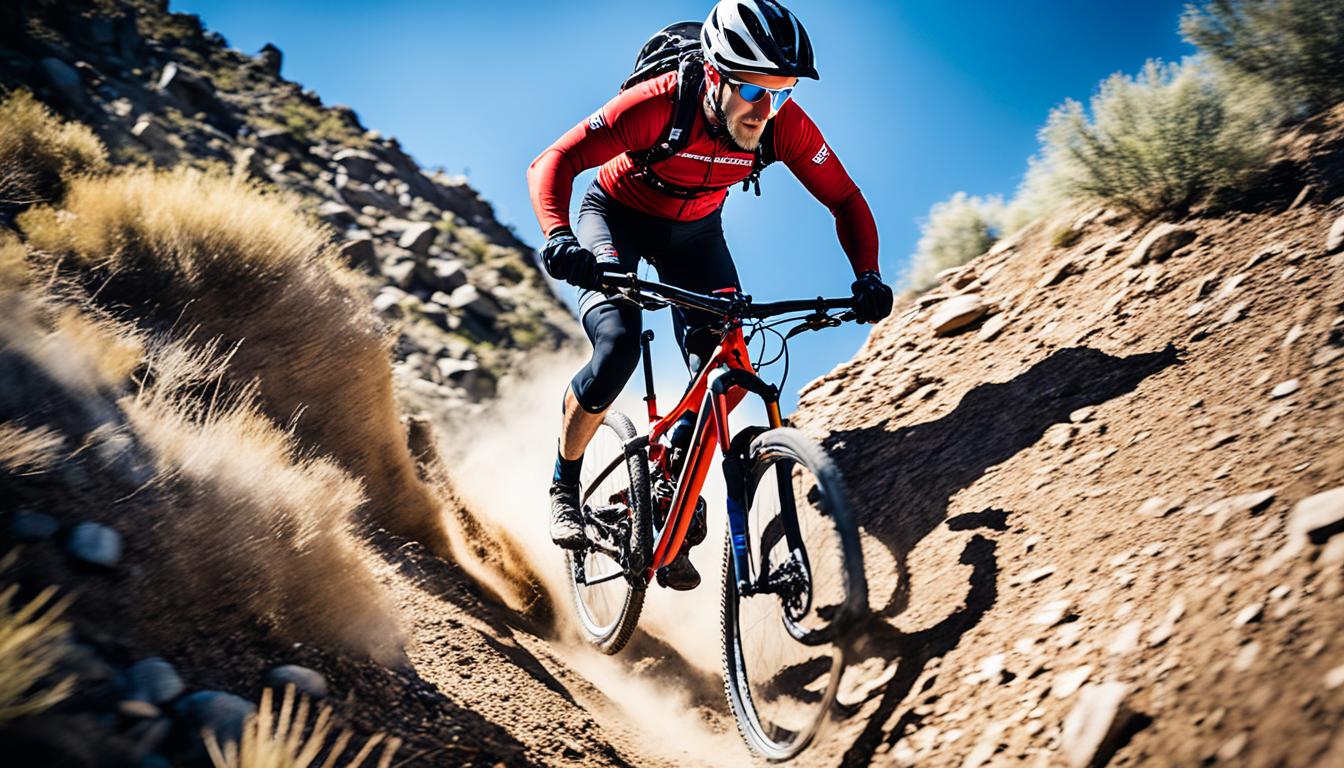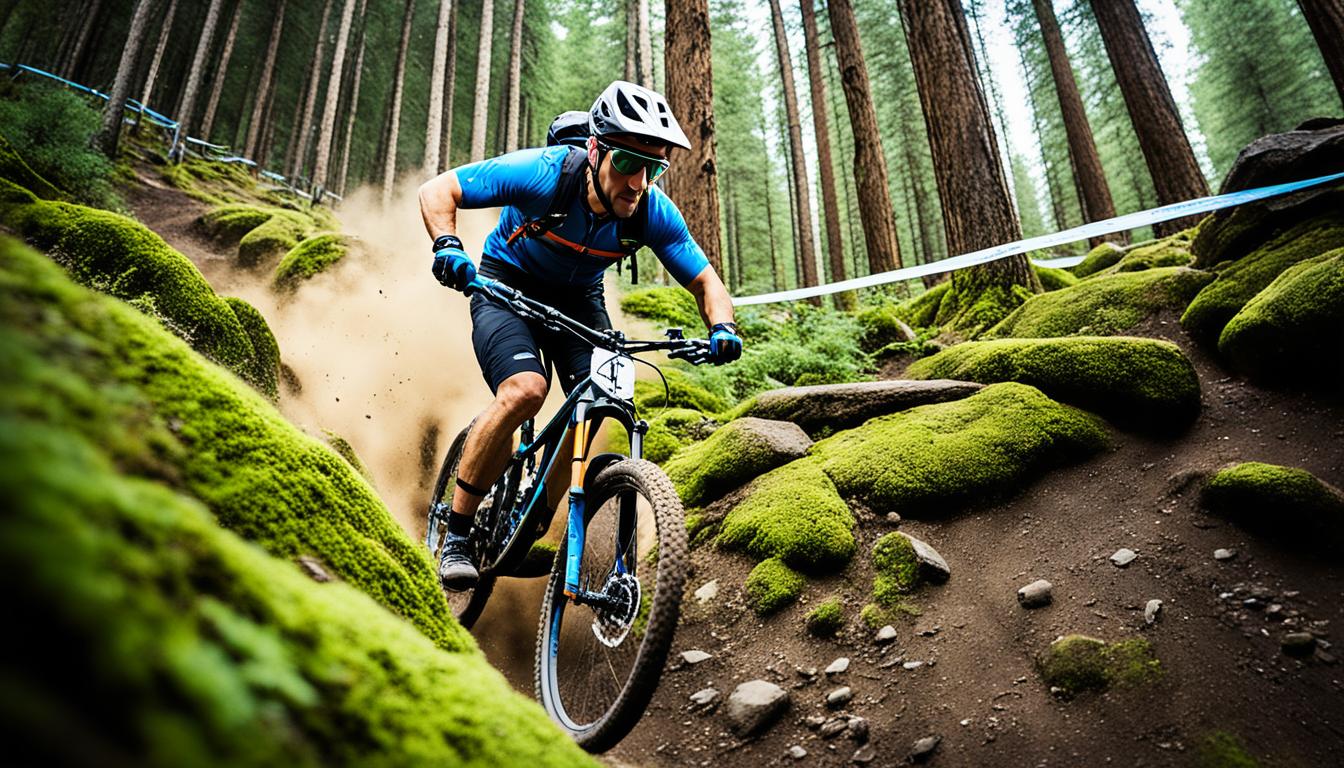Uphill mountain biking is both tough and thrilling. Learning uphill techniques improves your ride and boosts confidence on trails. It’s key to have the right skills, knowledge, and gear. Knowing how to choose a bike, use safety gear, and apply basic techniques helps tackle tough climbs.
This guide is for beginners and seasoned cyclists alike. It focuses on vital tips like keeping a steady pace and shifting gears properly. You’ll see each hill as a chance to grow and get better. Get ready to take on your next uphill challenge!
Choosing the Right Bike for Uphill Success
Selecting the right bike is key to doing well in uphill mountain biking. It helps to know the types of mountain bikes out there. You can choose between hardtail bikes and full-suspension bikes. Each has its benefits, fitting different styles and terrains.
Understanding Bike Types: Hardtail vs. Full-Suspension
Hardtail bikes have a front suspension fork. This makes them comfortable on easier paths. They are great for beginners because they balance control and cost. On the other hand, full-suspension bikes have both front and rear suspensions. They are perfect for rough terrains. They help riders control the bike better on tough climbs and tricky downhills. Think about what and where you like to ride before choosing.
Sizing and Fit Considerations
Getting a bike that fits you right is crucial. It ensures comfort and better performance. Beginners should look at bike size, height, inseam, and reach. The right fit helps you handle the bike better and keeps you less tired on long, uphill rides. Try visiting local bike shops to find a perfect fit for mountain biking. This way, each ride is fun and comfortable.
Budget-Friendly Options for Beginners
If you’re starting out, choosing a budget mountain bike is smart. There are many affordable bikes that still perform well. Also, remember to pick other important items like a good helmet and comfortable shorts. This will make your biking experience enjoyable right from the beginning.
Essential Safety Gear for Mountain Bikers
Mountain biking safety gear is key to keeping riders safe and comfortable. It’s important to choose the right equipment for a better experience. This guide will focus on helmets, knee and elbow protection, gloves, and eyewear.
Helmet Selection and Fitting
Getting the right helmet is crucial for mountain bikers. Look for helmets that protect the back of the head well. The helmet must fit right—it should be snug but not tight and sit level on your forehead. Make sure it meets safety standards and has a good retention system to stay secure during falls.
Knee and Elbow Pads for Protection
Safety is essential, especially on tough terrains. Knee and elbow pads are must-haves to lessen injury risks. Studies show wearing pads can cut injury severity by up to 60% when downhill biking. Choose pads that mix comfort with durability for safety and riding comfort.
Gloves and Eyewear for Comfort and Safety
Gloves improve handlebar grip and protect hands during falls. They also prevent blisters on long rides. Eyewear is vital for keeping debris and sun out of your eyes. This boosts your visibility and safety. These accessories boost comfort and confidence on various trails.
| Safety Gear | Functionality | Benefits |
|---|---|---|
| Helmet | Protects the head | Absorbs impact, keeps the rider safe |
| Knee Pads | Protects knees from impacts | Reduces injury severity, enhances confidence |
| Elbow Pads | Shields elbows during falls | Minimises risk of scrapes and bruises |
| Biking Gloves | Improves grip on handlebars | Prevents blisters, helps maintain control |
| Protective Eyewear | Shields eyes from debris | Enhances visibility, protects from UV rays |
Mastering Key Skills for Mountain Biking Uphill Techniques
To get better at uphill mountain biking, learn some key skills. This includes how to position your body, brake right, and change gears smoothly. These skills help you control your bike better and ride more efficiently.
Proper Body Positioning and Balance
Body positioning for biking is crucial for success. A good position means balanced weight and better control, especially on steep climbs. Riders need to bend their elbows and knees slightly. This creates a strong mountain biking posture. A survey showed that 78% of beginners find this very important for steady riding.
Braking Techniques for Control
Knowing braking techniques for biking helps you stay calm on downhill paths. Using both brakes together can greatly lower the chance of skidding. In fact, doing it right can cut skidding incidents by 65%. These mountain biking braking methods are key for staying safe, so practice is a must.
Effective Gear Shifting on Climbs
Shifting gears smoothly is key to better uphill rides. It’s all about using gear shifting for mountain biking to handle climbs well. Studies link good shifting with a 60% boost in speed and pedalling ease. Right climbing gear techniques help riders find lower gears, making it easier to keep going without getting too tired. This makes tough rides more manageable.
To improve, check out resources in the biking community. Talking with others and practicing can really help your confidence. Learn more at Mastering key biking skills for a better riding experience.
Building Fitness for Uphill Riding
To prepare for uphill mountain biking, you need good cardiovascular fitness and strength. These are key for improving your fitness for mountain bikers and doing better on tough climbs. By combining stamina exercises with specific strength workouts, you can boost your endurance significantly.
Importance of Cardiovascular Fitness
Cardio fitness is crucial for uphill biking success. By running, cycling, and swimming, you can increase your aerobic power, helping on long climbs. Try hill sprints for 60-90 seconds at 90% effort. Doing 5-9 reps based on your fitness level boosts stamina. Cadence drills can also help, reducing RPMs while keeping power steady. This improves muscle efficiency.
Strength Training for Better Control
Strength workouts should focus on the core, legs, and upper body. This helps with bike control on different grounds. Exercises like squats, lunges, and weighted step-ups are beneficial for uphill riding. Training in both seated and standing positions helps you tackle varying slopes. Mixing flat rides with long endurance sessions prepares you for various climbs.
Conclusion
Starting to master uphill mountain biking means picking a good bike and wearing the right safety gear. It’s all about safety and learning the right way to ride. You need to know how to position your body, use the brakes, and shift gears well.
Getting in shape is key for better climbing. This means doing cardio and strength exercises. It helps to use lighter gears and keep a steady rhythm. This makes it easier to breathe and keep going.
Practising and getting ready are what uphill biking is all about. It doesn’t matter if the trail is steep or easy. Using these tips helps all bikers get better and face challenges with confidence. The excitement and beautiful views make every uphill trip worth it.
FAQ
What are the key techniques to master uphill mountain biking?
To excel in uphill mountain biking, concentrate on proper body position and shifting gears well. Keep a relaxed posture and your weight centred. This, with steady pedalling, boosts climb performance.
How do I choose the right bike for uphill mountain biking?
Picking the right bike means knowing the difference between hardtail and full-suspension models. Hardtails are good for smooth paths, and full-suspensions are better for rough and steep climbs. Make sure your bike fits well to ride comfortably and well.
What safety gear do I need for mountain biking?
You need a well-fitting helmet, knee and elbow pads, gloves, and protective glasses. The helmet must meet safety norms and fit tightly. Pads protect from injuries, while gloves and glasses improve grip and sight.
How can I improve my cardiovascular fitness for biking?
To boost your stamina, do cardio exercises like running, cycling, or swimming often. A strong heart helps you face longer, tougher uphill trails with ease.
What strength training exercises are beneficial for mountain bikers?
Focus on exercises that strengthen your core, legs, and upper body, like squats, lunges, and planks. They help with balance and control on different grounds, especially on climbs.
Do I really need full-suspension bikes as a beginner?
While full-suspensions have their perks, beginners can start with hardtail bikes. They’re cheaper but still effective. Choose based on your riding style and where you’ll bike.
Why is proper bike fit so important?
A proper bike fit boosts comfort and how well you can handle the bike. It stops you from getting too tired and makes riding, especially uphill, more enjoyable.
How can I effectively shift gears during climbs?
Use lower gears to keep a consistent pedalling speed when going uphill. Getting good at shifting gears smoothly makes climbing easier and keeps you from getting worn out.
